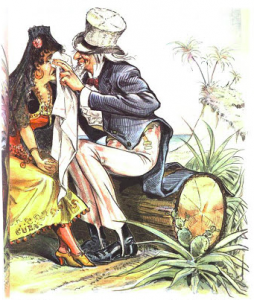In writing historical romances, authors must balance between historically accurate characters and characters which will appeal to contemporary readers. It’s no secret that many writers choose the latter. A member of my writing group shared a craft book which referred to the trope of the “Vegan Viking,” the historical hero who espouses anachronistic views of feminist equality. Particularly at this moment in history, I see the romance community redrawing the boundary line between predatory alpha-hole and acceptably forceful hero in discussion here, here, and elsewhere.
Popular fiction is often a reflection of social attitudes of its time. While I don’t have much idea of the historical context for Pamela or Pride and Prejudice, I have been reading about America’s Progressive Age, also known as the Gilded Age. It’s the time period when I’m setting my historical romances, and it’s the time when Johnston was writing To Have and To Hold. Some of what I’ve read has stuck in my mind because I found myself noticing reflections of 1890s issues and attitudes in Johnston’s story.
Masculinity and Virility
The first and most pervasive thread which I see running through To Have and To Hold is an ideal of masculinity. By the late 19th century, the west was won, Civil War veterans were aging out, and America was deprived of opportunities for men to prove their manliness. There was a cultural fear that the men were growing up soft and “over-civilized.” They were losing touch with their elemental barbaric natures. This is where you get an explosion of interest in physical culture, hunting, and mythologizing of American pioneers. This is the age of Buffalo Bill Cody’s Wild West Show, with staged battles between real soldiers and Indians. And, I think, an increased interest in America’s early colonists, who carved themselves out a home in the wilds of the New World.
Mary Johnston’s hero, Captain Percy, reflects this attitude by his presentation as a man’s man. He was the best swordsman in the Low Countries. He’s not afraid of death (until he has a wife to leave behind). He’s brash enough to bully his way into captaining a pirate crew. He’s great at dueling. He’s too smart to be poisoned. He is always chivalrous with his lady wife, but he is equally always ready to use violence to impose order on is subordinates.
Symbolism from the Spanish American War
This strong desire to prove masculinity, especially on the part of Teddy Roosevelt, was a direct cause for the Spanish-American War. (I’m drastically simplifying, of course — there was also a desire for American control of the Pacific and a healthy does of paternalism for the indigenous savages who were ill-served by the Catholic Spanish…) A splendid little war was just the thing to give the red-blooded American male something glorious to do in 1898.
With that context it’s pretty blatant for Johnston, writing in 1899, to introduce her story’s villain on a ship which is initially mistaken by the residents of Jamestown for a Spanish ship. This gives a chance for righteous speech as they mass on the palisades for battle, and we hear the priest Jeremy Sparrow tell the crowd:
We stand here not for England alone; we stand for the love of law, for the love of liberty, for the fear of God, who will not desert his servants and his cause, nor give over to Anti-Christ this virgin world.

While it’s ultimately a false alarm, the ship brings Lord Carnal to Jamestown and the scene serves to connect him with the enemy from the very beginning. He is also repeatedly described as darkly beautiful, which I suspect is meant not only to indicate his evilness, but also to continue his association with the Spanish by his complexion. He is dark-haired and passionate, which seems like a pretty strong overlay with stereotypes about the Spanish. If we read him as a stand-in for Spain, then the Lady Jocelyn might be Cuba, seeking independence and Captain Percy is the disinterested yet honorable military power who will save her — with the beneficial side effect that she comes under his influence instead.
Paternalism and White Supremacy
The same attitudes that led to the Spanish-American War are also evident, less palatably, in Johnston’s story. Captain Percy is casually cruel and domineering to Native Americans, who are generally described as noble savages. With those exact words. In the first chapter, Captain Percy’s character is established in the following actions…
When I had had my supper, I called from their hut the two Paspahegh lads bought by me from their tribe the Michaelmas before, and soundly flogged them both, having in my mind a saying of my ancient captain’s, namely, “He who strikes first oft-times strikes last.”
The only Native American who is portrayed positively—aka almost like a white man!—is the brother of Pocahontas, who is, incidentally, erased by use of the Christian name she took/was given.
It was Nantauquas, the Lady Rebekah’s brother, and the one Indian—saving always his dead sister—that was ever to my liking; a savage, indeed, but a savage as brave and chivalrous, as courteous and truthful, as a Christian knight.
Nantauquas is also described as “the bravest, comeliest, and manliest savage with whom I have ever dealt,” and acts as a sort of magical protector of Percy when he is on the verge of violent death at the hands of enemy Indians.
Nor are the indigenous inhabitants of Virginia the only ones given rude stereotypes. As a secondary villain, Johnston also gives us an Italian — an American immigrant group under suspicion of dividing their loyalties between America and the Pope during the 19th century. Johnston’s Italian is weak and womanly, acting as a stand-in for the heroine in a trap for Captain Percy, and getting no sympathetic descriptions when he’s on the page.
It was my Lord Carnal’s Italian doctor that I had so fished up. I had seen him before, and had found in his very small, mean figure clad all in black, and his narrow face with malignant eyes, and thin white lips drawn tightly over gleaming teeth, something infinitely repulsive, sickening to the sight as are certain reptiles to the touch.
And, unfortunately, unsurprisingly, Johnston also finds a way to bring in an African slave woman — “of the five females of her kind then in Virginia” who is described as “light of foot, soft of voice, ox-eyed and docile.” Since she only speaks a little Spanish, she has no speaking part and only serves briefly to wait upon Jocelyn.
As I’m writing my own books set in WASP America of the 1890s, it’s important for me to be aware of the attitudes and events of the time. I can see parallels between the late nineteenth century obsession with bodily health and twenty-first century interest in, say, Crossfit. Since my heroes were all college athletes, they fit nicely into that historical overlap. However, as with many other authors of historical fiction, I’ll definitely be discarding the more antediluvian ideas.


